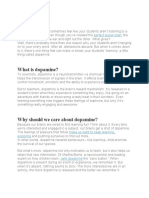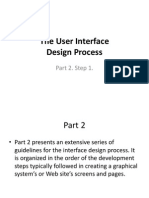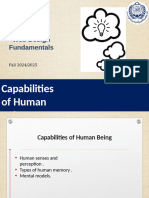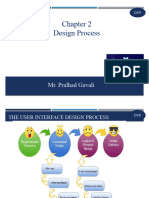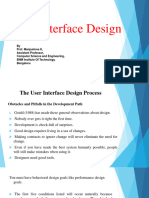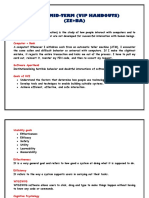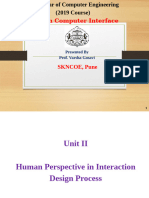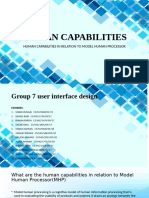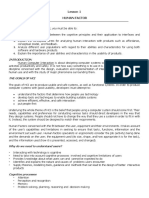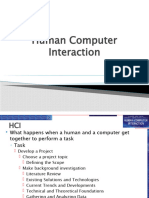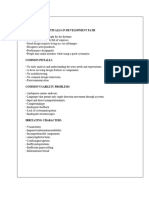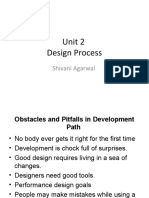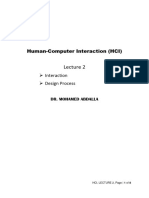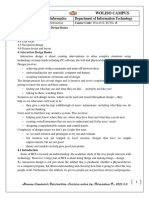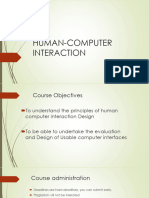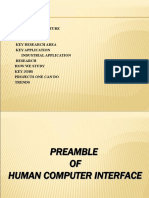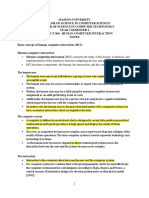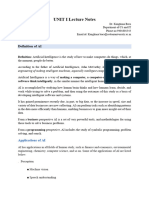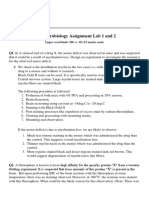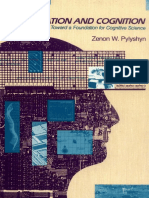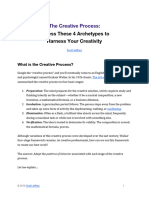HCI Unit-2 - Notes
HCI Unit-2 - Notes
Uploaded by
Khushi MaddheshiyaCopyright:
Available Formats
HCI Unit-2 - Notes
HCI Unit-2 - Notes
Uploaded by
Khushi MaddheshiyaOriginal Description:
Original Title
Copyright
Available Formats
Share this document
Did you find this document useful?
Is this content inappropriate?
Copyright:
Available Formats
HCI Unit-2 - Notes
HCI Unit-2 - Notes
Uploaded by
Khushi MaddheshiyaCopyright:
Available Formats
Human Computer Interface (KCS- 058) Unit-2
Design process
HCI Design
HCI design is considered as a problem solving process that has
components like planned usage, target area, resources, cost, and
viability. It decides on the requirement of product similarities to balance
trade-offs.
The following points are the four basic activities of interaction design −
Identifying requirements
Building alternative designs
Developing interactive versions of the designs
Evaluating designs
Three principles for user-centered approach are −
Early focus on users and tasks
Empirical Measurement
Iterative Design
Human interaction with computers:
Understanding How People Interact with Computers Characteristics of
computer systems, past and present, that have caused, and are causing,
people problems.
We will then look at the effect these problems have –
• Why people have trouble with computers
• Responses to poor design
• People and their tasks
Faculty-Mr. Abhishek Shahi Page 1
Human Computer Interface (KCS- 058) Unit-2
Why People Have Trouble with Computers-
• Extensive technical knowledge but little behavioral training.
• With its extensive graphical capabilities.
• Poorly designed interfaces.
• What makes a system difficult to use in the eyes of its user?
• Use of jargon
• Non-obvious design
• Fine distinctions
• Disparity in problem-solving strategies
• an "error-preventing" strategy
• Design inconsistency
Responses to poor design-
Typical psychological responses to poor design are:
Confusion
Frustration
Panic or stress
Boredom
Annoyance
People and their tasks –
These psychological responses diminish user effectiveness because they
are severe blocks to concentration.
--Thoughts irrelevant to the task at hand are forced to the user’s
attention, and necessary concentration is impossible.
--The result, in addition to higher error rates, is poor performance,
anxiety, and dissatisfaction Physical.
Faculty-Mr. Abhishek Shahi Page 2
Human Computer Interface (KCS- 058) Unit-2
Importance of 8 human characteristics human consideration:
Perception is our awareness and understanding of the elements and
objects of our environment through the physical sensation of our various
senses like sight, sound, smell and so on.
We tend to match objects or sensations perceived to things we already
know.
1. The goal in design is to utilize perceptual capabilities so screen can
be structured in the most meaningful and obvious way.
Perceptual characteristics include the following:
Proximity: Our eyes and mind see objects as belonging together if they
are near each other in space.
Similarity: Our eyes and mind see objects as belonging together if they
share a common visual property such as color, size, shape, brightness or
orientation.
Matching patterns: We respond similarly to the same shape in different
sizes.
Succinctness: We see an object as having some perfect or simple shape
because perfection or simplicity is easier to remember.
Closure: If something does not quite close itself such as circle, square,
triangle, or word we see it as closed anyway.
Unity: Objects that form closed shapes are perceived as a group.
Continuity: Shortened lines may be automatically extended.
Balance: We desire stabilization or equilibrium in our viewing
environment. Vertical, horizontal and right angles are the most visually
satisfying and easiest to look at.
Faculty-Mr. Abhishek Shahi Page 3
Human Computer Interface (KCS- 058) Unit-2
Expectancies: We perceive not what is there but what we expect to be
there. We see not how a word is spelled but how we expect to see it
spelled.
Context: Two drawn lines of the same length may look the same length
or different lengths depending on the angle of adjacent lines or what
other people have said about the size of the lines.
Signals versus noise: Our sensing mechanisms are bombarded by many
stimuli some of which are important some of which are not. Important
stimuli are called signals and not important or unwanted are called noise.
2. Memory:
Memory is viewed as consisting of two components long-term and
short-term memory.
Short-term or working memory receives information from either senses
or long-term memory or from both at once as the senses being processed
separately.
Information stored within short-term memory varies from 10 to 30
seconds and the memory storage capacity has gradually being lowered
from Miller’s 7±2 items to a size of 3-4 items.
Long-term memory contains the knowledge we possess. Information
received in short-term memory is transferred and encoded to it in
process known as learning.
Minimize the need for mighty memory in the design.
3. Sensory Storage:
Sensory storage is the buffer where the automatic processing of
information collected from our senses takes place.
Faculty-Mr. Abhishek Shahi Page 4
Human Computer Interface (KCS- 058) Unit-2
It is an unconscious process, large, attentive to the environment, quick to
detect changes and constantly being replaced by newly gathered stimuli.
Repeated and excessive stimulation can fatigue the sensory storage
mechanism, making it less attentive and unable to distinguish what is
important.
Eliminating interface noise will ensure that important things will be less
likely to be missed.
4. Visual Activity:
The capacity of the eye to resolve details is called visual activity.
The eye’s sensitivity increases for those characters closest to the fixation
point and decreases for those characters at extreme edges of the circle.
Patterns for fill in areas of screens must be carefully chosen to avoid
visual distraction as the eyes tremble slightly.
5. Foveal and Peripheral Vision:
Foveal vision is used to focus directly on something and peripheral
vision senses anything in the area surrounding the location we are
looking at.
Peripheral vision is thought to provide clues to where the eye should go
next in the visual search of a screen. Patterns, shapes and alignment
peripherally visible can guide the eye in a systematic way through
screen.
6. Information Processing:
There are two levels of information processing higher level and lower
level.
Faculty-Mr. Abhishek Shahi Page 5
Human Computer Interface (KCS- 058) Unit-2
Highest level is identified by consciousness and working memory which
is slow, limited and sequential which is used for reading and
understanding.
Lower level is identified without conscious effort and processes familiar
information rapidly and the limit of its capacity is unknown.
Visual distinctiveness of a screen is strong contributor. If a screen is
jammed with information and cluttered it loses its uniqueness and causes
more time consuming reading process.
7. Mental Models:
A mental model is simply an internal representation of a person’s current
understanding of something.
A person already familiar with one computer system will bring to
another system a mental model containing specific visual and usage
expectations.
If the new system complies with already established models it will be
much easier to learn and use.
8. Movement Control:
Provide large objects for important functions.
Take advantage of the pinning actions of the sides, top, bottom and
corners of the screen.
Human interaction speeds:
• The speed at which people can perform using various communication
methods has been studied by a number of researchers.
Faculty-Mr. Abhishek Shahi Page 6
Human Computer Interface (KCS- 058) Unit-2
• Reading: The average adult, reading English prose in the United
States, has a reading speed in the order of 250-300 words per minute.
Proof reading text on paper has been found to occur at about 200 words
per minute, on a computer monitor, about 180 words per minute.
• One technique that has dramatically increased reading speeds is called
Rapid Serial Visual Presentation, or RSVP. In this technique single
words are presented one at a time in the center of a screen. New words
continually replace old words at a rate set by the reader. For a sample of
people whose paper document reading speed was 342 words per minute.
(With a speed range of 143 to 540 words per minute.) Single words were
presented on a screen in sets at a speed sequentially varying ranging
from 600 to 1,600 words per minute. After each set a comprehension test
was administered.
UNDERSTAND THE BUSINESS FUNCTION
• Business definition and requirements analysis
--Direct methods
--Indirect methods
--Requirements collection guidelines
• Determining basic business functions
--Developing conceptual modes
--Understanding mental models
--Users new mental model
• Design standards or style guides
--Value of standards and guidelines
--Document design
--Design support and implementation
Faculty-Mr. Abhishek Shahi Page 7
Human Computer Interface (KCS- 058) Unit-2
• System training and documentation
-- Training
--Documentation
SCREEN DESIGNING
How to distract the screen user
• Unclear captions
• Improper type and graphic emphasis
• Misleading headings
• Irrelevant and unnecessary headings
• Inefficient results
• Clustered and cramped layout
• Poor quality of presentation
• Legibility
• Appearance
• arrangement
• Visual inconsistency
• Lack of design features
• Over use of 3D presentations
• Overuse of too many bright colors
• Bad typography
Variety of distractions
• Numerous audio and visual interruptions
• Extensive visual clutter
• Poor information readability
• In comprehensible screen components
• Confusing and inefficient navigation
• Inefficient operations
• Excessive or inefficient page scrolling
Faculty-Mr. Abhishek Shahi Page 8
Human Computer Interface (KCS- 058) Unit-2
• Information overload
• Design in consistency
• Outdated information
What screen users want
• an orderly clean clutter free appearance
• An obvious indication of what is being shown and what should be done
with it.
• Expected information located where it should be.
• A clear indication of what relates to what.
• Plain and simple english
• A clear indication of when an action can make a permanent change in
data
What screen users do
• Identifies a task to be performed or need to be fulfilled.
• Decides how the task will be completed or need fulfilled.
• Manipulates the computers controls.
• Gathers necessary data.
• Forms judgments resulting in decisions relevant to task.
Design goals
• Reduce visual work
• Reduce intellectual work
• Reduce memory work
• Reduce mentor work
• Eliminate burdens or instructions.
Faculty-Mr. Abhishek Shahi Page 9
You might also like
- Peri Institute of Technology: Department of Computer Science and Engineering Vii - SemesterDocument49 pagesPeri Institute of Technology: Department of Computer Science and Engineering Vii - Semester4012Aniruddh.R.K.No ratings yet
- Organizational BehaviourDocument37 pagesOrganizational Behaviourella4evaNo ratings yet
- Bruner - Learning Theory in EducationDocument7 pagesBruner - Learning Theory in EducationRandall RobertsNo ratings yet
- What Is Dopamine?: Perfect Lesson PlanDocument2 pagesWhat Is Dopamine?: Perfect Lesson Planausten ogbeideNo ratings yet
- The User Interface Design Process: Part 2. Step 1Document23 pagesThe User Interface Design Process: Part 2. Step 1Fiodor ZiuNo ratings yet
- Module 2Document21 pagesModule 2Sushmitha SaiNo ratings yet
- HCI Unit2Document15 pagesHCI Unit2Danish Ahmad KhanNo ratings yet
- Human Charactristics in DesignDocument23 pagesHuman Charactristics in DesignManjula grNo ratings yet
- UNIT II UidDocument28 pagesUNIT II UidjgjeslinNo ratings yet
- Human-Centered Design: Human Factors Within Interactive Digital Media Design & SoftwareDocument41 pagesHuman-Centered Design: Human Factors Within Interactive Digital Media Design & SoftwareNick ClarkeNo ratings yet
- Lecture 3 Sensory System & CognitiveDocument41 pagesLecture 3 Sensory System & CognitiveHuda GhaziNo ratings yet
- Imp HCI ExamDocument24 pagesImp HCI ExamWhite chilliesNo ratings yet
- 2 LEC - NEW2 - 15 - 3 - p1Document27 pages2 LEC - NEW2 - 15 - 3 - p1josama240No ratings yet
- Chapter 2 - Design Process - UIDDocument43 pagesChapter 2 - Design Process - UIDroNo ratings yet
- M2-The User Interface Design ProcessDocument74 pagesM2-The User Interface Design Processhetomo5120No ratings yet
- Carungcong HciDocument3 pagesCarungcong Hcibenedict carungcongNo ratings yet
- CS408 (Ze+ba Notes)Document10 pagesCS408 (Ze+ba Notes)Ali Ali100% (1)
- HCI Unit TwoDocument53 pagesHCI Unit TwoPrem KumarNo ratings yet
- HCIDocument5 pagesHCIanon_199410665No ratings yet
- HCI NotesDocument19 pagesHCI NotesAbcXyzNo ratings yet
- Usability Goals and Measures: Ch1: Usability of Interactive SystemsDocument4 pagesUsability Goals and Measures: Ch1: Usability of Interactive SystemsShaha MubarakNo ratings yet
- HCL Unit 2Document26 pagesHCL Unit 2ashwinibellale653No ratings yet
- Chapter 1 - The HumanDocument45 pagesChapter 1 - The HumanMD HOSSAINNo ratings yet
- Design Process HCI Design: Structure and Feedback Are The Seven Principles Used in Interface DesigningDocument7 pagesDesign Process HCI Design: Structure and Feedback Are The Seven Principles Used in Interface DesigningNAGA KUMARI ODUGUNo ratings yet
- Cognitive Ergonomics 1Document24 pagesCognitive Ergonomics 1ShenlandNo ratings yet
- User Modelling in UCSDDocument21 pagesUser Modelling in UCSDscjqvbns9mNo ratings yet
- CSIT226 Human Computer Interaction Tutorial 02 - Handout: Activity 01: Key TermsDocument6 pagesCSIT226 Human Computer Interaction Tutorial 02 - Handout: Activity 01: Key TermsnunuNo ratings yet
- UID Ia1Document10 pagesUID Ia1Arathi MNo ratings yet
- Group 1 System DesignDocument19 pagesGroup 1 System DesignangelingpastranaNo ratings yet
- Human Capabilities Slides Group7Document12 pagesHuman Capabilities Slides Group7officialmbaka615No ratings yet
- UNIT 2 - Design ProcessDocument18 pagesUNIT 2 - Design ProcessSai Venkat GudlaNo ratings yet
- Practical UXDocument85 pagesPractical UXharshanamalshangamage65No ratings yet
- Lesson 1 The HumanDocument8 pagesLesson 1 The HumanEderlyn Pangilinan RamosNo ratings yet
- Chapter 1Document58 pagesChapter 1thiri minzawNo ratings yet
- Bautista, IT-11 SEATWORK#1 IHCIDocument4 pagesBautista, IT-11 SEATWORK#1 IHCIJohn Patrick BautistaNo ratings yet
- Unit IiDocument28 pagesUnit IiSuramsetti LingaiahNo ratings yet
- Unit 2 Design Process: Shivani AgarwalDocument46 pagesUnit 2 Design Process: Shivani AgarwalShivani AgarwalNo ratings yet
- Chapter 2 DetailedDocument8 pagesChapter 2 DetailedEmyNo ratings yet
- Hci 2Document19 pagesHci 2Abhishek JoshiNo ratings yet
- 4 22865 CS451 2018 1 1 1 CS451 HCI 01 Introduction To HCI and Design PrinciplesDocument39 pages4 22865 CS451 2018 1 1 1 CS451 HCI 01 Introduction To HCI and Design PrinciplesOmniah AlshameryNo ratings yet
- MMG 3033 - Human Computer Interaction: Hci QuestionDocument8 pagesMMG 3033 - Human Computer Interaction: Hci QuestionNor Arinah Hanani100% (1)
- Hci-Unit-2-Short NotesDocument28 pagesHci-Unit-2-Short NotesMuru GanNo ratings yet
- Human-Computer-Interaction Lesson 1Document9 pagesHuman-Computer-Interaction Lesson 1Albert TanNo ratings yet
- Ch_1Document80 pagesCh_1Samson WorkinehNo ratings yet
- Sit 308 Human Computer InterfaceDocument2 pagesSit 308 Human Computer Interfaceshem nyangateNo ratings yet
- DLT Unit-2Document50 pagesDLT Unit-2TONY 562No ratings yet
- Pertemuan 3Document35 pagesPertemuan 3Danang KurniawanNo ratings yet
- HCI - Lecture 2Document94 pagesHCI - Lecture 2MD.HASIBUL HASAN, 180041104No ratings yet
- Internship ContentDocument33 pagesInternship Contenttimepass6996.maNo ratings yet
- Hci CH4Document7 pagesHci CH4Tolosa TafeseNo ratings yet
- CMP 441 StudentDocument88 pagesCMP 441 Studentmichyarus15No ratings yet
- Design Process: Obstacles and Pitfalls in Development PathDocument33 pagesDesign Process: Obstacles and Pitfalls in Development PathNitraNtcNo ratings yet
- Hci UciDocument166 pagesHci UciHassan Ali AbbasiNo ratings yet
- BelayDocument6 pagesBelayabrahammijenaNo ratings yet
- Preamble PPT Eit401wt.080310Document26 pagesPreamble PPT Eit401wt.080310Nidhi2408No ratings yet
- CCS 302 Human Computer Interaction - NotesDocument82 pagesCCS 302 Human Computer Interaction - NotesSupport ArtNo ratings yet
- unit 4-2Document5 pagesunit 4-2ChetanNo ratings yet
- Obstacles and Pitfalls in Development Path: Unit-IiDocument10 pagesObstacles and Pitfalls in Development Path: Unit-IipradeepNo ratings yet
- Hci - Unit - 1Document46 pagesHci - Unit - 1ARCCHANANo ratings yet
- Introduction To HCI (Week 1)Document22 pagesIntroduction To HCI (Week 1)Amna AmjidNo ratings yet
- Important Questions- HCIDocument28 pagesImportant Questions- HCIgshif05No ratings yet
- 1 AI UNIT I Lecture NotesDocument16 pages1 AI UNIT I Lecture NotestanmaydaskashyapNo ratings yet
- Basic Principles of an Operating System: Learn the Internals and Design PrinciplesFrom EverandBasic Principles of an Operating System: Learn the Internals and Design PrinciplesNo ratings yet
- Genius Talent Development ProgramDocument37 pagesGenius Talent Development ProgramsongaonkarsNo ratings yet
- Artificial Intelligence: Chapter 4 Introduction To Knowledge Base SystemsDocument20 pagesArtificial Intelligence: Chapter 4 Introduction To Knowledge Base SystemsZeeshan BhattiNo ratings yet
- Objectives of ResearchDocument17 pagesObjectives of ResearchMadhuNo ratings yet
- For Printing Week 1 PerdevDocument8 pagesFor Printing Week 1 PerdevmariNo ratings yet
- Long Quiz 1 - BAED-HUMSS2121Document9 pagesLong Quiz 1 - BAED-HUMSS2121Almirah Makalunas100% (1)
- Cohen, & Hicks. Prospective Memory. 2017Document111 pagesCohen, & Hicks. Prospective Memory. 2017Dafny C. AroneNo ratings yet
- Self Unbound Ego Dissolution in PsychedelicDocument11 pagesSelf Unbound Ego Dissolution in Psychedelicszucsanna123456789No ratings yet
- History of Cognitive PsychologyDocument6 pagesHistory of Cognitive PsychologyNicula RobertNo ratings yet
- Rossemblat Paper On Writing and Reading. The Transactional TheoryDocument26 pagesRossemblat Paper On Writing and Reading. The Transactional TheoryBruno JiménezNo ratings yet
- 2023 Manifesting PlannerDocument529 pages2023 Manifesting Plannerhey its me100% (1)
- Guilbert Levels of Educational Objectives - MunirDocument3 pagesGuilbert Levels of Educational Objectives - Munirkushluv3875% (4)
- Ankur Bhaumik 18895 UB201L Neurobiology Assignment Lab 1 and 2 PDFDocument4 pagesAnkur Bhaumik 18895 UB201L Neurobiology Assignment Lab 1 and 2 PDFAnkur BhaumikNo ratings yet
- Chunks For TKT YlDocument7 pagesChunks For TKT YlChaw Kay Khine HtooNo ratings yet
- Jaylyn Paulino Mind MappingDocument5 pagesJaylyn Paulino Mind Mappingviraaj pawarNo ratings yet
- Clearing Limiting Beliefs TimecodesDocument4 pagesClearing Limiting Beliefs TimecodesRonaldo MessiNo ratings yet
- Zenon W. Pylyshyn - Computation and Cognition - Toward A Foundation For Cognitive Science.-Mit Press (1985)Document308 pagesZenon W. Pylyshyn - Computation and Cognition - Toward A Foundation For Cognitive Science.-Mit Press (1985)Edgar Jonathan UgaldeNo ratings yet
- E Kruglanski Et Al 1996 Motivated Social Cognition PDFDocument17 pagesE Kruglanski Et Al 1996 Motivated Social Cognition PDFtira87No ratings yet
- Group 8 SemioticsDocument14 pagesGroup 8 SemioticsPBI 02 UIN RAFA 2020No ratings yet
- Introduction To EducationDocument76 pagesIntroduction To EducationHina Kaynat100% (1)
- Information Seeking Behavior: An: Padmvati S Tubachi Research Scholar Rayalseema University, KurnoolDocument5 pagesInformation Seeking Behavior: An: Padmvati S Tubachi Research Scholar Rayalseema University, KurnoolRon MamoloNo ratings yet
- Canales de Aprendizaje OficialDocument18 pagesCanales de Aprendizaje OficialIsabel FloresNo ratings yet
- Describe and Evaluate The Working Memory ModelDocument4 pagesDescribe and Evaluate The Working Memory ModelNahimaNo ratings yet
- Multicultural Lesson Plan Format Student: Emani Pegues Subject/Concepts: Math Grade Level: KindergartenDocument4 pagesMulticultural Lesson Plan Format Student: Emani Pegues Subject/Concepts: Math Grade Level: Kindergartenapi-623069948No ratings yet
- The Creative Process Scott JeffreyDocument16 pagesThe Creative Process Scott JeffreyNastase Catalina CristinaNo ratings yet
- Yin, J. (2021) - Mindset and individual learning in the workplace: A systematic review and future agenda. 經濟學研究, 71 (1), 7-26Document22 pagesYin, J. (2021) - Mindset and individual learning in the workplace: A systematic review and future agenda. 經濟學研究, 71 (1), 7-26Julie Ann BagamaspadNo ratings yet
- Social Learning TheoryDocument28 pagesSocial Learning TheoryjellaNo ratings yet
- Module 09Document8 pagesModule 09Lea Cazzandra T. PumanesNo ratings yet



